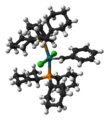Organic chemistry facts for kids

Organic chemistry is the study of chemical compounds that contain carbon. Carbon has the ability to form a chemical bond with a wide variety of chemical elements and other carbon atoms. This allows a nearly unlimited number of combinations. The subject of carbon compounds is called organic chemistry because all known organisms, or living things, are made up of water and carbon compounds. Organic chemistry largely involves the synthesis, or formation, of organic products by chemical reaction using different reactants and reagents, the substances used up during a reaction. Several different areas of chemistry expand on the concepts and principles of organic chemistry, including biochemistry, microbiology, and medicine.
Contents
History
The term organic originates from Jons Jacob Berzelius, a 19th century Swedish scientist, who used the term to refer to substances present in living things. During Berzelius’ time, the vital force theory was popular. This theory stated that a life force was needed to produce the organic compounds found only in living things. The vital force theory began losing support after an 1828 experiment conducted by Friedrich Wöhler. His work showed that urea, an organic compound, could be created from ammonium cyanate, an inorganic compound.
Hydrocarbons
The study of hydrocarbons is a very large part of organic chemistry. Hydrocarbons are molecules containing only the elements carbon and hydrogen in the form of chains. Hydrocarbons can be classified into two categories based on the presence of a benzene ring, a circular type of hydrocarbon. Aliphatic hydrocarbons do not contain a benzene ring and aromatic hydrocarbons do.
Reactions
Organic chemistry reactions happen because electrons are not shared evenly in a chemical bond. Some atoms or molecules, like oxygen, nitrogen, and negatively charged anions, are nucleophilic because they have extra electrons and want to be around positive charges. Others, such as H+ and other positively charged cations, are electrophilic and want to be around negative charges. When an organic molecule has a positive charge, it is called a carbocation. It is also an electrophile. When nucleophiles and electrophiles mix, a reaction can occur.
Common reaction mechanisms
A reaction mechanism is a series of smaller reactions that form an overall reaction. Two basic mechanism types are substitution and elimination reactions. They are very important in the study of organic chemistry mechanisms because many more complicated mechanisms use them.
Substitution Reactions (SN1 & SN2)
Nucleophilic substitution occurs when an atom or group of atoms detaches from an organic molecule and is replaced by another. If the leaving and adding happens at the same time, it is called a SN2 reaction. If the leaving group breaks away from the organic molecule and forms a carbocation before substitution occurs, it is called an SN1 reaction.
Elimination Reactions (E1 & E2)
Elimination occurs when two groups are broken off of an organic molecule by a strong acid and the resulting charges form a double bond. Usually one of the groups is a nucleophile and the other is a hydrogen atom. If both groups are pulled off at the same time, it is called an E2 reaction. If one group is pulled off first and forms a carbocation before the second group is removed, it is called an E1 reaction.
Stereochemistry
Stereochemistry is the study of molecules in space. It looks into the arrangement of atoms inside of molecules in space relative to one another and how they will interact. Molecules that have the same chemical make up but are arranged differently are called isomers. Famous chemist Louis Pasteur was an early researcher of stereochemistry.
A central part of the study of sterochemistry is chirality. Put simply, chirality looks at the symmetry in chemical molecules. If an object cannot be superimposed onto its mirror image, then it is a chiral object. If it can, it is called achiral.
Spectroscopy
Spectroscopy is the study of the interactions between light energy and matter. We are able to see colors because of energy absorption by organic and inorganic compounds. When a plant undergoes photosynthesis, it traps energy from the sun, and this is an example of an interaction between energy and organic compounds.
Spectroscopy is used to identify organic molecules in unknown compounds. There are many types of spectroscopy, but most important to organic chemistry are infrared spectroscopy and nuclear magnetic resonance spectroscopy.
- Journal of Organic Chemistry (subscription required) (Table of Contents)
- Organic Letters (Pubs.ACS.org, Table of Contents)
Images for kids
-
An example of an organometallic molecule, a catalyst called Grubbs' catalyst. Its formula is often given as RuCl2(PCy3)2(=CHPh), where the ball-and-stick model is based on X-ray crystallography. The single metal atom ruthenium (Ru), (in turquoise), is at the very center of the structure; two chlorines (green), are bonded to the ruthenium atom—carbon atoms are black, hydrogens gray-white, and phosphorus orange. A phosphorus-ligand bond, tricyclohexyl phosphine, PCy, is below center; (another PCy ligand appears at the top of the image where its rings are obscuring one another). The ring group projecting to the right, an alkylidene, contains a metal-carbon double bond to ruthenium.
-
This diagram shows 5 distinct structural representations of the organic compound butane. The left-most structure is a bond-line drawing where the hydrogen atoms are removed. The 2nd structure has the hydrogens added depicted-the dark wedged bonds indicate the hydrogen atoms are coming toward the reader, the hashed bonds indicate the atoms are oriented away from the reader, and the solid (plain) bonds indicate the bonds are in the plane of the screen/paper. The middle structure shows the four carbon atoms. The 4th structure is a representation just showing the atoms and bonds without 3-dimensions. The right-most structure is a condensed structure representation of butane.
-
A synthesis designed by E.J. Corey for oseltamivir (Tamiflu). This synthesis has 11 distinct reactions.
See also
 In Spanish: Química orgánica para niños
In Spanish: Química orgánica para niños




